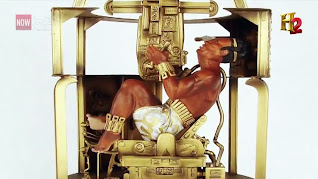Pakal was buried in a stone sarcophagus in the largest of Palenque’s pyramids, known as the Temple of the Inscriptions, after he died in 683A.D. The entrace of the tomb itself discovered in 1948 by the Mexican archaeologist Alberto Ruz Lhuillier , butt it took four years to finally dig through and open it.
a.ii) The mysterious influence
On 15th June 1952 the tomb of the Mayan king Pakal was
discovered, with it's very elaborate lid.
Soon we would find tthat Picasso painted a picture of a goat skull, a bottle and a candle which looked very much inspired in a simplified way by the tomb lid. In the following year, Dalí painted a picture of a Chariot of the Greek god Bacchus that resembled a combination of Pakal’s tomb lid and Picasso’s goat skull, bottle and candle.
Also in 1952, rocket scientist Wernher Von Braun drew an illustration of a towering lunar lander rocket ship that looked roughly inspired by the design on the tomb lid. This was published in the October 1952 edition of Collier’s magazine, and on the cover was a painting of such a space craft by his usual illustrator Chesley Bonestell based on that illustration and also inspired by the tomb lid itself.
Were these all inspired by the discovery of the tomb lid?
Archaeology can tell us all about the symbolic structures in the tomb lid’s design and how they have nothing to do with flight into outer space, but show us more about the Mayan mythological beliefs in relation to inner space.
There are a lot of creative things one can do with such a tomb lid design. I’m sure that many artists have been inspired by it in different ways without having to turn it into a pilot with rocket ship.
I suspect also that the Fisher-Price teaching clock as seen in the 1970s was loosely based upon the same tomb lid.
a.iii) Transforming ancient imagery into space technology ?
It appears that in the 1955 Disney documentary about space flight where Wernher Von Braun shared his idea, in the cutaway illustration of the space ring we might suddenly notice that it partly seemed inspired by illustrations from the Egyptian book of the dead and the illustrator had turned a Mummification Ritual vignette into the astronomy department, turning the pharaoh’s mummified body into what might be a telescope, although no one is actually going to make the suggestion that ancient Egyptian mummies were the astronomical telescopes of the day. It suggested that Wernher Von Braun and his team of thinkers turned to Ancient Egyptian imagery for abstract inspiration, which I suspect Fisher-Price toys were later doing as well in an incredible way.
a.iv) Birthing of an ancient alien theory?
Late in the 1960s, Erich von Daniken released the book Chariots of the Gods making the bold assertion that the tomb lid depicted a man piloting a rocket ship. He based his claims on the similarity between rocket ship technology that he had seen since the 1960s. While we do see a man encapsulated in other mythological imagery that might make some think of a capsule structure, what he didn’t account for was the possibility that Wernher Von Braun had simply been inspired by this incredible relief of a man in an after life state, and that’s why we see some loose similarities.
If Wernher hadn’t taken any notice of the relief, we might have seen his inspiration taking a slightly different turn. Perhaps one might assume that way the astronauts were seated in the capsule might even have been different as well.
h). See: Mayan Rocket Man segment from "Chariots of the Gods" documentary
i). See: Mayan Rocket Man segment from "The case of Ancient Astronauts" documentary
p) Mayan Rocket Man mural (Brazil, 2010?) (Source https://artgraff.livejournal.com/192782.html )
q) See: Ancient Aliens enthusiasts transform tomb lid image into a rocket ship?






















No comments:
Post a Comment